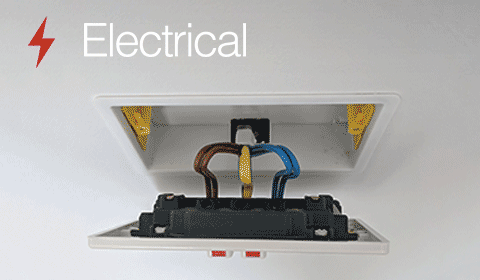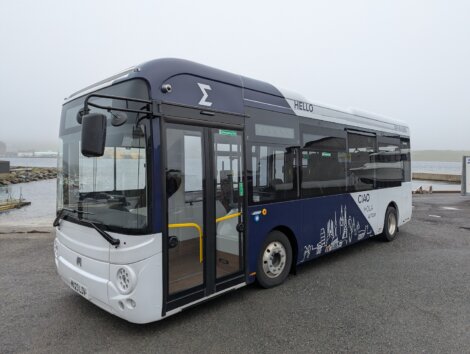Transport / Trial assessing how electric bus fares in ‘Shetland context’
The trial, which is funded by the government, will allow the SIC to compare its performance against a diesel bus
COULD electric buses be a thing of the future in Shetland?
A trial of one – a Sigma 8 – is ongoing around Shetland at the moment thanks to funding from the UK Government.
The local media was given a look at the battery-powered electric bus on Monday morning on a return trip from Lerwick to Scalloway.
It was fairly quiet and comfortable, and not that much different from your usual trip on the service four bus into Scalloway and back.
Less clunky, perhaps, than most of your usual public service buses – and it seemed to manage to get up the Scord no problem.
The leased bus is taking part in a four-month trial led by Shetland Islands Council (SIC) to see how electric buses fare on Shetland’s roads and in the local weather.
The trial is costing around £200,000, which is fully funded by the UK Government as part of the ‘rural energy hub’ project which mainly focuses on revamping the Brae Youth Centre.
It will include journeys with and without passengers, but they will not be used for public services.
There was supposed to be two electric buses in the trial but the second has succumbed to “sourcing issues”, leaving just one.
Members of the media were joined on the short trip by some of those involved in the trial – transport contracts and operational officer Elaine Park, climate change officer Steven MacLean and councillor Moraig Lyall, who chairs the environment and transport committee.
Speaking at the halfway point in Scalloway, the trio all seemed fairly positive about the trial so far – as was the driver, who worked for a local operator.
Park said the trial has gone “really good” so far, with the aim being to gather as much information as possible on how it works in Shetland.
Become a member of Shetland News
“What we’ve been doing is basically covering all the service bus routes exactly as they currently are, so it’s very easy to then compare to a diesel equivalent,” she said.
“And we can progress the trial from empty buses to adding in more stop features, to eventually adding weight on board.”
There has been concern from some over how electric buses could fare going up steep inclines, and Park said a key factor of the trial is to understand how it works in the “Shetland context”.
“The technology performs well,” she added, “[but] it’s how long it will perform for. It’s ultimately how much we can get out of the charge of the bus that we’re effectively trying to gain over the trial.”
The manufacturer’s brochure claims the bus has a “range” of up to 160 miles before needing charged, but Park said that – as expected – the trial is showing up with less.
At the end of the trial, she said, there will be a “Shetland number” which can be used to work out what is possible in the local context.
The bus has been getting charged overnight, and staff have been trying out varying the power use on the inside of the vehicle too, such as when the heating is on full blast.
The weather has been pretty mild since the trial has been carried out – with the bus not going out in anything less than three degrees so far.
Councillor Lyall said she could envisage electric buses ultimately being rolled out in Shetland in the years ahead.
“I imagine that at some point in the future there will be [electric buses],” the Shetland Central member added.
“It’s the direction of travel, and it might not be next year, but I’d imagine at some point there will be.”
Lyall said decarbonisation of all aspects of the council is important, and transport is a key area with a lot of work to be done.
“Bringing new technology is the way to do that, and so only by trialling it and seeing it can work in a Shetland context can we actually make progress with this,” the councillor said.
Lyall also said it was also beneficial that the trial gives the chance for operators to try it out.
“It’s a big commitment to make that decision to invest in new technology, so giving them a chance to try before you buy is important.”
For climate change officer MacLean the trial is a “great opportunity” – particularly as it not costing the council anything to run.
“So, whatever the findings are, it’s great data,” he said.
One other potential future fuel source for buses could be hydrogen – with ones already operating down south, including in Aberdeen.
Production of hydrogen is also plotted for Shetland, in the North Mainland, in the coming years.
But MacLean said it was difficult to predict how things might pan out with emerging technology.
“I think part of the challenge here is that nobody really knows where the future of the industry is going,” he said, referring to how hydrogen was touted as a possible solution for larger vehicles a few years ago.
“But battery technology is getting better at such a rate that I think that’s in question. Nobody knows the answer to this.
“It’s the whole climate change transition; who’s to say that whatever the next iteration will be the last – there might be a fleet of electric vehicles and then in another 10 or 15 years it switches to hydrogen.
“The honest answer is we don’t know yet. But we’re at the very early stages of gathering data and what it would mean for us if we were switching to electric at this moment in time.”
It was mentioned that Shetland, and its electric vehicle chargers, is mainly powered by fossil fuels at the moment – until next year when Lerwick Power Station goes into standby as the isles connects to the national grid for the first time – but MacLean said it would be “crazy” not to take up the opportunity of the funding just now.
Become a member of Shetland News
Shetland News is asking its readers to consider paying for membership to get additional perks:
- Removal of third-party ads;
- Bookmark posts to read later;
- Exclusive curated weekly newsletter;
- Hide membership messages;
- Comments open for discussion.
If you appreciate what we do and feel strongly about impartial local journalism, then please become a member of Shetland News by either making a single payment, or setting up a monthly, quarterly or yearly subscription.
















































































